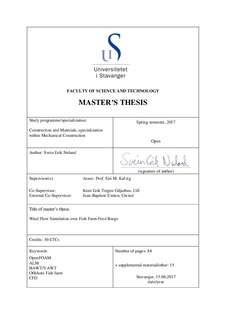| dc.contributor.advisor | Kalvig, Siri M. | |
| dc.contributor.advisor | Giljarhus, Knut Erik Teigen | |
| dc.contributor.advisor | Curien, Jean-Baptiste | |
| dc.contributor.author | Nuland, Svein Erik | |
| dc.date.accessioned | 2017-10-19T08:05:34Z | |
| dc.date.available | 2017-10-19T08:05:34Z | |
| dc.date.issued | 2017-06-15 | |
| dc.identifier.uri | http://hdl.handle.net/11250/2460955 | |
| dc.description | Master's thesis in Mechanical engineering | nb_NO |
| dc.description.abstract | There are approximate over 1000 fish farms in Norway, where half are connected to the grid and the rest are driven by diesel generators. Fish farms use large air compressors to feed the fish, which creates high power consumption. To reduce the diesel consumption and C02 emissions, created by the compressors, there are companies that specialize in providing green energy solutions. Gwind is a Stavanger based energy company that provide off-grid energy for this exact purpose. A master study done by H. Syse showed that a hybrid system with wind turbines, PV, Li-Ion batteries and two diesel generators over a 20-year period would reduce the CO2 emissions and lower the diesel consumption.
Investigation of local wind flow and power generation with a wind turbine linked to the fish farm feed barge, was performed using the open source computational fluid dynamics (CFD) software OpenFOAM. The wind turbine is a vertical axis wind turbine (VAWT), modeled by an actuator line model (ALM). The ALM has been implemented with the use of a library called turbinesFoam.
A framework for wind flow simulations over fish farm feed barges has been developed. This framework includes a ALM of a VAWT, simulated with OpenFOAM’s pimpleFoam solver, and k-epsilon turbulence model. The inlet is enriched with atmospheric boundary layer.
The framework has been used on two fish farm cases, Tallaksholmen and Nordheim. These are owned by Grieg Seafood Rogaland, and in collaboration with Gwind a wind measurement campaign was conducted, and cross-referenced with nearby wind stations to set an approximately real inflow condition.
The framework was used to investigate the optimal height placement of the VAWT on Tallaksholmen, coupled with a cost benefit analysis. To show the flexibility of the framework the second fish farm case, Nordheim, was setup and ready to run within a few hours. In this case the performance was increased, as a result of investigating the local wind flow before activating the turbine.
Based on the results of this study, it is recommended to install a VAWT on the Tallaksholmen fish farm feed barge. The operational performance should be compared against the simulations to further verify the computational approach. | nb_NO |
| dc.language.iso | eng | nb_NO |
| dc.publisher | University of Stavanger, Norway | nb_NO |
| dc.relation.ispartofseries | Masteroppgave/UIS-TN-IKM/2017; | |
| dc.rights | Navngivelse 4.0 Internasjonal | * |
| dc.rights.uri | http://creativecommons.org/licenses/by/4.0/deed.no | * |
| dc.subject | maskinteknikk | nb_NO |
| dc.subject | maskinkonstruksjon | nb_NO |
| dc.subject | cfd | nb_NO |
| dc.subject | vawt | nb_NO |
| dc.subject | materialer | nb_NO |
| dc.subject | konstruksjoner | nb_NO |
| dc.subject | fish farm | nb_NO |
| dc.title | Wind Flow Simulation over Fish Farm Feed Barge | nb_NO |
| dc.title.alternative | Wind Flow Simulation over Fish Farm Feed Barge | nb_NO |
| dc.type | Master thesis | nb_NO |
| dc.subject.nsi | VDP::Technology: 500::Mechanical engineering: 570 | nb_NO |

